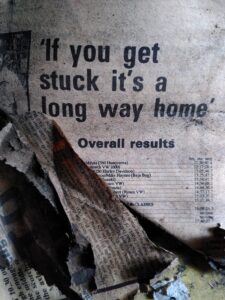In undoing one home to build another, I would like to leap over the hoarding. I would climb over the boards temporarily erected around the building site, and start up the digger, the chainsaw. I would avoid all mention of the stuff inside the old house. I would skip it.
Robin Nagle notes the peculiarity of the English phrase to ‘throw away’:
We don’t ‘put’ it away, which would imply saving it, or ‘place’ it somewhere, which suggests handling it with care. We ‘throw’ it, thus putting it far from ourselves, to an ‘away’ about which we know little. In today’s developed nations, ‘away’ means landfills or recycling facilities or waste-to-energy plants [incinerators].*
I could call up and order a volume of emptiness – an 8-yard, a 12-yard, a 40-yard skip – to be taken away again once I’d filled it with whatever.
But the aim is to build a house that will be part of a regenerative circuit, made of locally grown materials, producing energy, capable of repair and growth. Finding the right place to ‘place’ what’s on site now is part of that process.

‘If you get stuck, it’s a long way home’. Newspaper found under carpet: Motor Cycle News December 1, 1976
*Robin Nagle, Picking Up (Farrar, Strauss and Giroux, 2013), page 29.